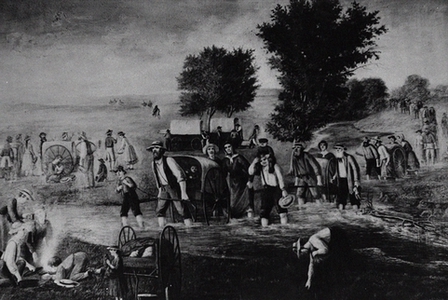CHRISTENSEN, CARL CHRISTIAN ANTON

Handcart Pioneers, C.C.A. Christensen
Carl Christian Anton Christensen was born in Copenhagen, Denmark, in 1831, and studied at the Royal Academy of Art in Copenhagen from 1847 to 1853. He converted to Mormonism in 1850 and served three LDS missions to Scandinavia: from 1853 to 1857; from 1865 to 1867; and from 1887 to 1889. He translated the lyrics for many LDS hymns into Danish; some are still in the LDS Scandinavian hymn book. In 1857 he emigrated to America from Liverpool aboard the Perpetual Emigrating Fund ship and then pulled a handcart across the plains to Utah. Settling in Sanpete County, he homesteaded in Mt. Pleasant, Fairview, and finally in Ephriam, where he also worked as a house and decorative painter. He married two Norwegians in polygamy--Elise Scheel Haarby in 1857 and Maren Petterson in 1868.
Christensen was an ardent champion of Scandinavian culture and taught Danish as well as drawing at Sanpete Stake Academy (later Snow College) in Ephriam. He served as a reporter and later as editor for the Bikuben, Utah's Danish/Norwegian newspaper. In 1901 he began working in the LDS Church Historical Department, compiling the history of the Scandinavian Mission. Christensen is not only a very important nineteenth-century Utah painter, he also wrote extensively and eloquently about art theory, Mormon history, theology, and rural Utah social life. Many of his writings still exist in original form in the archives of the LDS Church Historical Department.
In 1900 he painted Handcart Pioneers (in the collection of the LDS Museum of Church History and Art), which has become the most widely published painting of the Mormon pioneer experience by an actual pioneer. He painted murals in the St. George and Manti temples and in the Ephraim tabernacle. He is most famous for his twenty-two (originally twenty-three) paintings of pre-Utah Mormon history. These large (7'x10') paintings, painted over several years beginning in 1878, begin with Joseph Smith's early religious experience in New York State and end with the entry of the Mormon pioneers into the Salt Lake Valley in 1847. They were sewn together in a scroll and presented along with a historical lecture in towns and cities in Utah, Arizona, Wyoming, and Idaho. In this manner Christensen was able to overcome the limited patronage base for art in pioneer rural Utah. The "Mormon Panorama," as it is known, has become a most significant visual representation of the early period of Mormon history, and has been published and widely exhibited, for example, at the Whitney Museum in New York in 1970. This panorama along with more than seventy-five other paintings by Christensen establish him as the most important visual historian among all nineteenth-century painters in Utah as well as one of the two (along with Danquart Weggeland) most important Scandinavian artists in pioneer Utah. Christensen was a passionate historian who painted with a much broader social intention than simple self-expression. This paragraph about his "Mormon Panorama" is typical of his writings:
"The old generation who bore the burdens of the day in the persecutions in Ohio, Missouri, and Illinois will no longer be with us a few years hence. History will preserve much, but art alone can make the narrative of the suffering of the Saints comprehensible for posterity."
Disclaimer: Information on this site was converted from a hard cover book published by University of Utah Press in 1994. Any errors should be directed towards the University of Utah Press.